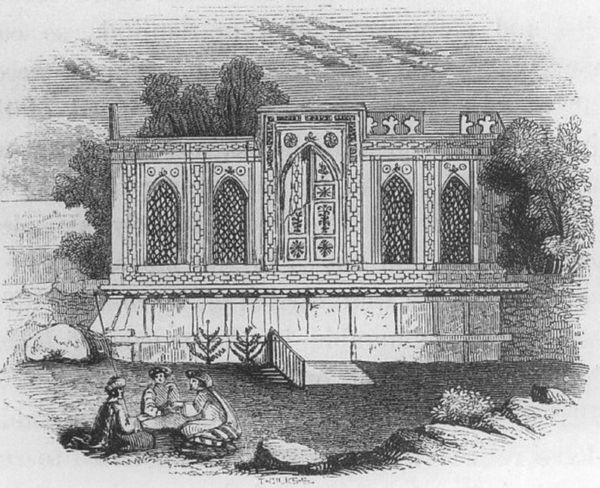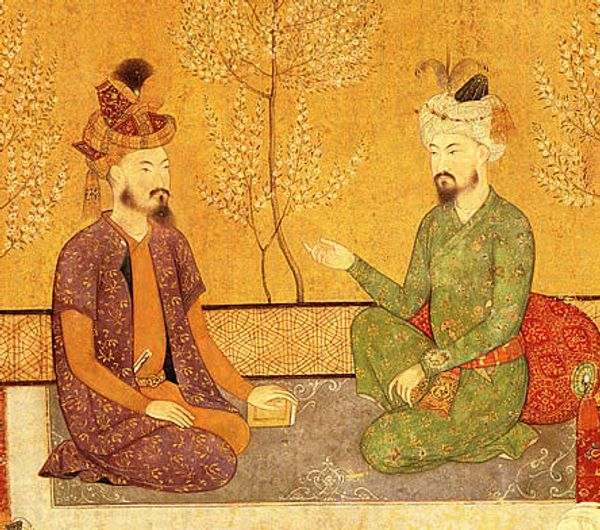In the month of Ramzan of the year 899 (June 1494), a 12-year-old boy became the ruler of the Farghana. This 12-year-old boy the son of Umar Shaikh Mirza (whose father was the son of Timur Beg) and grandson of Yunus Khan (from the family of Chagtai Khan the son of Genghis Khan) is famously known as Mughal Emperor Babur, the founder and first Emperor of the Mughal Empire.
Early Life and Family Background of Mughal Emperor Babur
Born on 14 February 1483 in Andijan, Timurid Empire (present-day Uzbekistan) as Ẓahīr ad-Dīn Muḥammad, Babur Mirza was a direct descendant both from the Timur as well as Genghis Khan clan.
Babur was the eldest son of Umar Shaikh Mirza, the ruler of the Ferghana valley from his first wife Qutlugh Nigar Khanum, a princess of the Chagatai Khanate and daughter of Yunus Khan of Moghulistan. He had 7 consorts in all.
He had a sister Khanzada Begum, two other half brothers – Nasir Mirza and Jahangir Mirza and 4 other half sisters – . Meher Banu Begum, Sheher Banu Begum, Yadgar Sultan Begum and Rukaiya Sultan Begum. Since his father died at a very young age (38 years), Babur was made the ruler of Ferghana at the age of 12.
His Accession: From The Ferghana Ruler to the Founder of Mughal Empire in India
After ascending the throne of Ferghana in 1495, Babur faced revolt from his own family and relatives.In 1497, he conquered Samarkand but lost the city of Ferghana soon after that. As odd as it seems, in his plight to reconquer Ferghana (his own kingdom), he lost his control over Samarkand.
4 years later in 1501, he tried to recapture both the cities. However, his efforts went in vain when Muhammad Shaybani Khan, a Uzbek leader and descendant of Shiban, the 5th son of Genghis Khan’s eldest son Jochi defeated him.
In 1504, Babur captured Kabul from the Arghuns under Mukim Beg Arghun and became the new king of Kabul and the entire Ghazni regions. This siege gave him respite from all his Central Asia troubles which helped him to build a strong foundation, enough to conquer northern India.
During that time, Rajputana was ruled by Rajput Confederacy led by Mewar’s Rana Sanga and the the Indo-Gangetic Plain of the northern Indian Subcontinent was ruled by Ibrahim Lodi of the Lodi dynasty.
Babur gave full attention to siege North India. In 1519, he reached Chenab. Till 1524, all he wanted was to expand his power to Punjab but things turned in Babur’s favor when he received invitations from Daulat Khan Lodi, Governor of Punjab and Ala-ud-Din, uncle of Ibrahim Lodi – the rebels of the Lodhi dynasty.
Next, he sent an ambassador to Ibrahim, claiming himself to be the rightful heir to the throne, but they detained the ambassador at Lahore.
When Babur appeared in the neighborhood of Lahore his onward march was halted by Daulat Khan himself who was now repenting his act of treachery against the Sultan of Delhi. He then led an army of 40,000 men against Babur.
However, he not only overpowered Daulat Khan’s army men but also chased them throughout the streets of Lahore.- burning the city’s bazaar and looting everything in the process.
In November, 1525, Babur with Humayun his eldest son set out on invading India against Ibrahim Lodhi. In April 1526, the two came face-to-face on the plains of Panipat where Babur not only defeated Ibrahim Lodi in the First Battle of Panipat (1526) but also founded the Mughal empire.
Next, he faced opposition in the form of Mewar’s Rana Sanga. However, Babur was successful in defeating Rana Sanga in the Battle of Khanwa in 1527.
Also Read: Why the Rulers of Mewar Use the Title Rana and Maharana and Not Raja
Personal Relationships, Family and Wives of Mughal Emperor Babur
Babur had no great interest in women as such. His first wife Aisha Sultan Begum was his paternal cousin – the daughter of Sultan Ahmad Mirza, his father’s brother. She was only an infant when she betrothed to a five year old Babur.
They married when Babur was 16 in 1498–99. The couple together had one daughter Fakhr-un-Nissa. It is said that Babur was very “bashful” towards Aisha Begum post he lost his affection. He had several other wives and concubines.
In his memoirs, there is a special mention of Babur’s infatuation for younger boy when he was 16. During that time, bisexuality was common and in high fashion among the central Asian aristocrats.
After Aisha Begum left Babur in 1504, he married Zaynab Sultan Begum. However, she died within two years without any child. Next, in the period from 1506 to 08, he married four women, Maham Begum (the mother of the eldest son Humayun), Masuma Sultan Begum (died during childbirth), Gulrukh Begum (the mother of Kamran and Askari) and Dildar Begum (mother of the youngest son Hindal and grandmother of Ruqaiya Begum Sultan – wife of Akbar).
Later, Babur married Mubaraka Yusufzai, from the Yusufzai tribe. He also had two Circassian slaves Gulnar Aghacha and Nargul Aghacha who became recognized ladies of the royal household.
The Hobbies, Interests of Mughal Emperor Babur
The Mughal emperor was never religious and so he never drank until he was 30. Post that he started drinking regularly and even used to host alcohol parties at regular intervals.
He even started consuming preparations made from opium. However, he quit drinking before the Battle of Khanwa for health reasons. In years of peace when he stayed in Kabul he took interest in gardening, literature, music as well as art.
Also Read: Mughal Emperor Aurangzeb Chronicles: Early Life, Education, Interests & Family Life!
Death and Legacy of Mughal Emperor Babur
On 5 January 1530, Babur died at the age of 47. He was succeeded by his eldest son, Humayun who became the second Mughal emperor. His body was buried in Kabul, Afghanistan, in Bagh-e Babur (Babur Gardens).

He is considered a national hero in Uzbekistan. In 2008, stamps were issued in his name to commemorate his 525th birth anniversary on 14th February. Some of his poems are quite popular as Uzbek folk songs. In the year 2005, Pakistan even named their Cruise Missile (Babur Cruise Missile) in his honour.
Source and References:
The Baburnama – Memoirs of Babur in English – Gutenberg Project
Abdul Gafoor Abdul Majeed Noorani (2003), The Babri Masjid question, Tulika Books, ISBN 81-85229-78-3
Tarikh-i-Rashidi – A History of the Moghuls of Central Asia
Babur: Founder of the Mughal Empire in India (1985) by Manohar Publications


